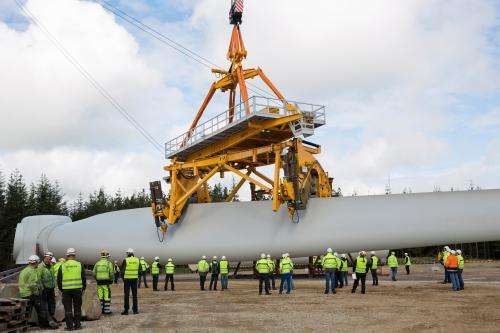Lifting mechanism for mounting huge rotor blades

Siemens has created a special mechanism for mounting its 75-meter-long rotor blades for offshore wind farms. The lifting system makes assembly work safer and lets construction take place at higher wind speeds than was previously the case. Until now, rotor blades had to be lifted by their hubs using long clamping tools attached to a crane on an installation ship. In this process, cables fasten the blade to the tool at two points. The assemblers have to attach and tighten these cables by hand. Depending on how many rotor blades are stacked on the ship, the assemblers have to work tens of meters above the deck, and do so even at night and in bad weather. The new mechanism fastens and tightens the cables fully automatically and is controlled safely from the ship's deck. Siemens developed the system for the series installation of its new D6 platform wind turbines.
During the construction of wind turbines, the rotor blades have traditionally been fitted to the hub, after which the whole assembly was mounted on the rotor at the top of the mast. However, single blade assembly is becoming increasingly common. Although this is especially the case on land, it is also being used more and more at sea. In this setup, the hub is already fitted on the rotor and the crane lifts each blade to the tower, where it is attached by assemblers in the nacelle. This single-blade assembly process is the only method that can be used for the latest generation of rotor blades, which are 75 meters long and weigh 25 tons. A pre-assembled rotor with a diameter of 154 meters and a weight of about 75 tons would be almost impossible to transport or to align to the hub.
Engineers at Siemens Wind Power therefore looked for a fully automatic solution for the series assembly of such huge rotor blades. The process also had to be usable in strong winds so that the construction ship could be employed as efficiently as possible. That's why the engineers faced the challenge of having to create a system that was as light as possible, but still offered sufficient stability. The new lifting mechanism is 14 meters long and eight meters high, and weighs 78 tons. It can be used in winds with sustained speeds of up to 14 meters per second and gusts of up to 19 meters per second - the equivalent of wind force 7 on the Beaufort scale. The current limit for single-blade assembly is a wind speed of 12 meters per second.
The lifting mechanism automatically tightens and releases the cables that secure the rotor blades. As a result, it can also be used to remove assembled rotor blades when maintenance work has to be carried out. All functions are redundant to ensure the rotor blades can be safely brought back on deck. Moreover, the new system can turn, tip, and swivel, enabling it to lift rotor blades no matter how they are positioned on the ship. The system can also tip or swivel the rotor blades during fitting so that they can be precisely aligned to the hub. Previous techniques were unable to readjust the positions of the blades in this manner.
The new lifting mechanism was given its first assignment this summer, when it began to build the Westermost Rough wind farm off England's east coast. Siemens is installing 36 wind turbines at this site, each with 75-meter rotor blades.
Provided by Siemens




















